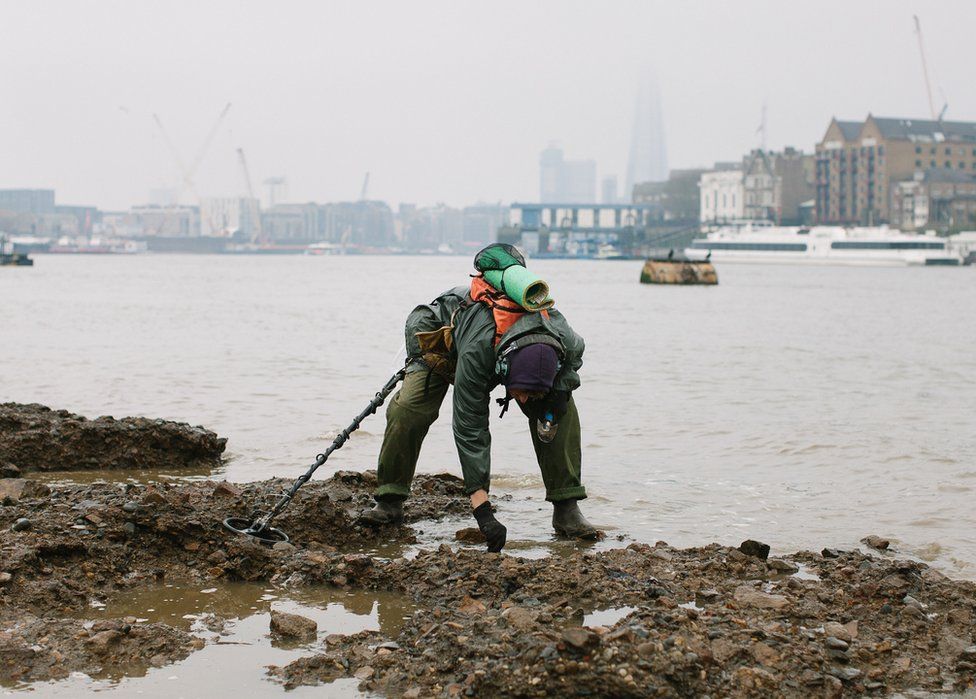Hunting for treasure at low tide
- Published

Joseph Fox photographed the mudlarkers who comb the shore of London's River Thames. Originally a term for the city's poor who scraped a meagre living by scavenging in the river's mud, it has been adopted by a new breed of treasure hunters, often armed with metal detectors.
These men and women show off their favourite finds, and discuss the joys of mudlarking.
Dave Hiddleston, Limehouse
Long fascinated by history and collecting, Dave first discovered mudlarking while he was working on Cannon Street and saw people on the foreshore in wellington boots.
His favourite find is an English community cloth seal, which he believes was used to stamp cloth bags coming through London in about 1618. It was inside a lump of burnt cinder.
Dave said: "I am always encouraging others to go mudlarking. It is a great escape from the humdrum of modern life, and interesting doing research on your finds.
"Plus you get to meet some really interesting like-minded people."
Edward Sandling, Vauxhall
Ted discovered mudlarking by chance. "I was walking along South Bank," he said, "and I just hopped over a gate and came down to the foreshore. You get a sense of quietude and the perspectives on the city are so different, just by that small change of level."
He then noticed the objects at his feet, such as this pipe stem shaped like a horse's hoof. He said: "I have finds that are older and perhaps more beautiful, but this is the one that set it all off.
"It's absolutely beautiful. To hold it and know that someone else was smoking it 150 to 200 years ago is amazing."
Ted believes that London's beauty lies in the fact that it hasn't all been embanked, and its tides allow these things to be found on the beaches: "It churns up discoveries every day. Every tide there are new things to be found."
The one item he is holding out for is a Bartmann jug, decorated stoneware from Germany that was used to transport food, drink and goods. For Ted, "they inspire thoughts of darkly forested mountains".
Andrea Smith, Rotherhithe
Although she began only in October last year, Andrea makes time to go to the shore up to six times a week. She uses a metal detector, alongside her eyes and a trowel, to find shards of pottery such as this, painted with a willow pattern.
Andrea said: "It does not happen often that a shard contains both doves.
"I have found great joy, serenity and peace with my soulmate and best friend, my husband Iain. This shard represents this to me."
Sara Cannizzaro, Vauxhall
It's the unexpectedness of mudlarking that drew Sara to it, in contrast to the routine of London life.
"I feel the excitement when I'm walking along the bank," she said. "It's a way of making order out of chaos."
Sara has managed to find a piece of Bartmann jug, which - from the splashes of cobalt blue glaze - she has dated to 1600-20, made in Frechen.
She said: "The face that was impressed on the neck of these jugs is a prized find from all mudlarkers - everyone wants to find one!"
Mark Smalley, Rotherhithe
Mark picks the shore in Rotherhithe because of the area's history as the place where pilgrims sailed to America, making him believe it is easier to find trader tokens and hammered coins.
He uses a metal detector, explaining: "You're looking for the black areas where there's a lot of erosion - that's hopefully where your history will be. The hard pack underneath holds the history."
His favourite find is a potted ham jar lid, which despite being only Victorian, is very rare as it is intact.
The peacefulness of mudlarking is what appeals to Mark. "The whole world is buzzing above you and you're just out of it completely," he said. "You're just in your own world."
Anyone wishing to search the tidal Thames foreshore in any way for any reason must hold a current foreshore permit from the Port of London Authority.
All photographs taken by Joseph Fox.